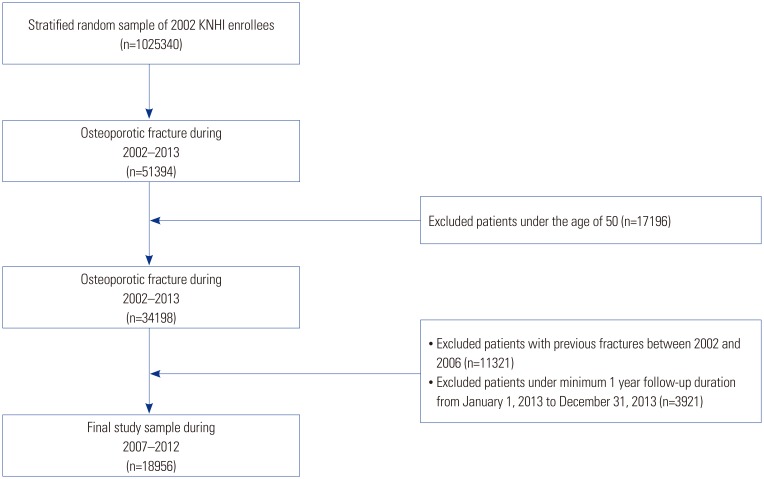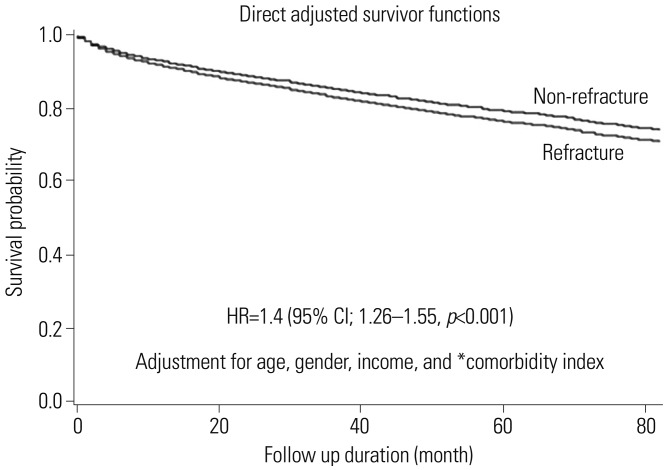Yonsei Med J.
2019 Oct;60(10):969-975. 10.3349/ymj.2019.60.10.969.
Incidence and Mortality of Osteoporotic Refractures in Korea according to Nationwide Claims Data
- Affiliations
-
- 1Department of Orthopaedic Surgery, Gyeongsang National University Hospital, Jinju, Korea.
- 2Department of Orthopaedic Surgery, Chung-Ang University College of Medicine, Seoul, Korea. hayongch@naver.com
- 3Institute of Health Science, Gyeongsang National University, Jinju, Korea.
- 4Department of Preventive Medicine, Gyeongsang National University School of Medicine, Jinju, Korea.
- 5Department of Orthopaedic Surgery, Seoul National University Bundang Hospital, Seongnam, Korea.
- KMID: 2459150
- DOI: http://doi.org/10.3349/ymj.2019.60.10.969
Abstract
- PURPOSE
Studies on the incidence and mortality of refractures after primary osteoporotic fracture are limited by the relatively rare incidence of such refractures and small sample sizes. The objectives of this research were: 1) to determine the incidence of osteoporotic refractures and fracture locations and 2) to assess mortality rates associated with osteoporotic refracture over a median follow up of 3 years using nationwide claim database.
MATERIALS AND METHODS
Patients over 50 years of age who had an osteoporotic fracture that was confirmed operationally were enrolled. Refracture was defined as that after 6 months of an untreated period. Mortality rate was calculated using the Charlson comorbidity index and was analyzed using Cox proportional hazards regression analysis.
RESULTS
A total of 18956 first-time instances of osteoporotic fracture were reported between 2007 and 2012 after a median follow up of 3.1 years (range, 1 to 7 years). Among 18956 patients, 2941 (15.50%) experienced refracture. After follow up for 1 year, cumulative mortality rates for re-fracture and non-refracture groups were 9.1% and 7.2%, respectively. After adjusting for covriates, mortality rate was 1.2 times greater in patients with re-fracture than in patients without re-fracture over a median follow up of 3 years (hazard ratio: 1.20, 95% confidence interval: 1.08-1.34, p<0.001).
CONCLUSION
The incidence of osteoporotic re-fracture in this nationwide study was 15.5%, and the mortality rate of re-fracture patients was 1.2 times higher than that of non-refracture patients over a median follow up of 3 years.
MeSH Terms
Figure
Cited by 1 articles
-
Introducing big data analysis using data from National Health Insurance Service
EunJin Ahn
Korean J Anesthesiol. 2020;73(3):205-211. doi: 10.4097/kja.20129.
Reference
-
1. Lems WF, Raterman HG. Critical issues and current challenges in osteoporosis and fracture prevention. An overview of unmet needs. Ther Adv Musculoskelet Dis. 2017; 9:299–316. PMID: 29201155.
Article2. Kontis V, Bennett JE, Mathers CD, Li G, Foreman K, Ezzati M. Future life expectancy in 35 industrialised countries: projections with a Bayesian model ensemble. Lancet. 2017; 389:1323–1335. PMID: 28236464.
Article3. Doherty DA, Sanders KM, Kotowicz MA, Prince RL. Lifetime and five-year age-specific risks of first and subsequent osteoporotic fractures in postmenopausal women. Osteoporos Int. 2001; 12:16–23. PMID: 11305078.
Article4. Dennison E, Mohamed MA, Cooper C. Epidemiology of osteoporosis. Rheum Dis Clin North Am. 2006; 32:617–629. PMID: 17288968.
Article5. Lee YK, Kim JW, Lee MH, Moon KH, Koo KH. Trend in the age-adjusted incidence of hip fractures in South Korea: systematic review. Clin Orthop Surg. 2017; 9:420–423. PMID: 29201294.
Article6. Teng GG, Curtis JR, Saag KG. Mortality and osteoporotic fractures: is the link causal, and is it modifiable? Clin Exp Rheumatol. 2008; 26(5 Suppl 51):S125–S137.7. Nazrun AS, Tzar MN, Mokhtar SA, Mohamed IN. A systematic review of the outcomes of osteoporotic fracture patients after hospital discharge: morbidity, subsequent fractures, and mortality. Ther Clin Risk Manag. 2014; 10:937–948. PMID: 25429224.8. Jung HJ, Park YS, Seo HY, Lee JC, An KC, Kim JH, et al. Quality of life in patients with osteoporotic vertebral compression fractures. J Bone Metab. 2017; 24:187–196. PMID: 28955695.
Article9. Wu CH, Chen CH, Chen PH, Yang JJ, Chang PC, Huang TC, et al. Identifying characteristics of an effective fracture liaison service: systematic literature review. Osteoporos Int. 2018; 29:1023–1047. PMID: 29525971.
Article10. Noordin S, Allana S, Masri BA. Establishing a hospital based fracture liaison service to prevent secondary insufficiency fractures. Int J Surg. 2018; 54(Pt B):328–332. PMID: 28919380.
Article11. Chang YF, Huang CF, Hwang JS, Kuo JF, Lin KM, Huang HC, et al. Fracture liaison services for osteoporosis in the Asia-Pacific region: current unmet needs and systematic literature review. Osteoporos Int. 2018; 29:779–792. PMID: 29285627.
Article12. Binkley N, Blank RD, Leslie WD, Lewiecki EM, Eisman JA, Bilezikian JP. Osteoporosis in crisis: it's time to focus on fracture. J Bone Miner Res. 2017; 32:1391–1394. PMID: 28556236.
Article13. Stolnicki B, Oliveira LG. For the first fracture to be the last. Rev Bras Ortop. 2016; 51:121–126. PMID: 27069877.
Article14. Dreinhöfer KE, Féron JM, Herrera A, Hube R, Johnell O, Lidgren L, et al. Orthopaedic surgeons and fragility fractures. A survey by the Bone and Joint Decade and the International Osteoporosis Foundation. J Bone Joint Surg Br. 2004; 86:958–961. PMID: 15446517.15. Johnell O, Kanis JA, Odén A, Sernbo I, Redlund-Johnell I, Petterson C, et al. Fracture risk following an osteoporotic fracture. Osteoporos Int. 2004; 15:175–179. PMID: 14691617.
Article16. Lauritzen JB, Lund B. Risk of hip fracture after osteoporosis fractures. 451 women with fracture of lumbar spine, olecranon, knee or ankle. Acta Orthop Scand. 1993; 64:297–300. PMID: 8322584.
Article17. Kanis JA, Johnell O, De Laet C, Johansson H, Oden A, Delmas P, et al. A meta-analysis of previous fracture and subsequent fracture risk. Bone. 2004; 35:375–382. PMID: 15268886.
Article18. Park YG, Jang S, Ha YC. Incidence, morbidity and mortality in patients older than 50 years with second hip fracture in a Jeju cohort study. Hip Pelvis. 2014; 26:250–255. PMID: 27536589.
Article19. Cheung CL, Ang SB, Chadha M, Chow ES, Chung YS, Hew FL, et al. An updated hip fracture projection in Asia: The Asian Federation of Osteoporosis Societies study. Osteoporos Sarcopenia. 2018; 4:16–21. PMID: 30775536.
Article20. Kim L, Kim JA, Kim S. A guide for the utilization of Health Insurance Review and Assessment Service National Patient Samples. Epidemiol Health. 2014; 36:e2014008. PMID: 25078381.
Article21. Yoon HK, Park C, Jang S, Jang S, Lee YK, Ha YC. Incidence and mortality following hip fracture in Korea. J Korean Med Sci. 2011; 26:1087–1092. PMID: 21860561.
Article22. Park C, Ha YC, Jang S, Jang S, Yoon HK, Lee YK. The incidence and residual lifetime risk of osteoporosis-related fractures in Korea. J Bone Miner Metab. 2011; 29:744–751. PMID: 21644058.
Article23. Choi HJ, Shin CS, Ha YC, Jang S, Jang S, Park C, et al. Burden of osteoporosis in adults in Korea: a national health insurance database study. J Bone Miner Metab. 2012; 30:54–58. PMID: 21633927.
Article24. Lee YK, Jang S, Jang S, Lee HJ, Park C, Ha YC, et al. Mortality after vertebral fracture in Korea: analysis of the National Claim Registry. Osteoporos Int. 2012; 23:1859–1865. PMID: 22109741.25. Lee YK, Ha YC, Park C, Yoo JJ, Shin CS, Koo KH. Bisphosphonate use and increased incidence of subtrochanteric fracture in South Korea: results from the National Claim Registry. Osteoporos Int. 2013; 24:707–711. PMID: 22618268.
Article26. Kang HY, Yang KH, Kim YN, Moon SH, Choi WJ, Kang DR, et al. Incidence and mortality of hip fracture among the elderly population in South Korea: a population-based study using the national health insurance claims data. BMC Public Health. 2010; 10:230. PMID: 20438644.
Article27. Lee YK, Ha YC, Yoon BH, Koo KH. Incidence of second hip fracture and compliant use of bisphosphonate. Osteoporos Int. 2013; 24:2099–2104. PMID: 23247329.
Article28. Brozek W, Reichardt B, Zwerina J, Dimai HP, Klaushofer K, Zwettler E. Antiresorptive therapy and risk of mortality and refracture in osteoporosis-related hip fracture: a nationwide study. Osteoporos Int. 2016; 27:387–396. PMID: 26576544.
Article29. Kim KH. Comorbidity adjustment in health insurance claim database. Health Policy Manag. 2016; 26:71–78.
Article30. Hsiao PC, Chen TJ, Li CY, Chu CM, Su TP, Wang SH, et al. Risk factors and incidence of repeat osteoporotic fractures among the elderly in Taiwan: a population-based cohort study. Medicine (Baltimore). 2015; 94:e532. PMID: 25700317.31. Center JR, Bliuc D, Nguyen TV, Eisman JA. Risk of subsequent fracture after low-trauma fracture in men and women. JAMA. 2007; 297:387–394. PMID: 17244835.
Article32. Ruan WD, Wang P, Ma XL, Ge RP, Zhou XH. Analysis on the risk factors of second fracture in osteoporosis-related fractures. Chin J Traumatol. 2011; 14:74–78. PMID: 21453571.33. Nakayama A, Major G, Holliday E, Attia J, Bogduk N. Evidence of effectiveness of a fracture liaison service to reduce the re-fracture rate. Osteoporos Int. 2016; 27:873–879. PMID: 26650377.
Article34. Klotzbuecher CM, Ross PD, Landsman PB, Abbott TA 3rd, Berger M. Patients with prior fractures have an increased risk of future fractures: a summary of the literature and statistical synthesis. J Bone Miner Res. 2000; 15:721–739. PMID: 10780864.
Article
- Full Text Links
- Actions
-
Cited
- CITED
-
- Close
- Share
- Similar articles
-
- Incidence of Osteoporotic Refractures Following Proximal Humerus Fractures in Adults Aged 50 Years and Older in Korea
- Incidence and Mortality of Osteoporotic Fracture in Rheumatoid Arthritis in South Korea Using Nationwide Claims Data
- Sensitivity of Medical Insurance Claims Data Using Population-based Cancer Registry Data
- Methods for Estimation of Nationwide Cancer Incidence from Population-based Cancer Registries
- Urinary Incontinences Are Related with Fall and Fragility Fractures in Elderly Population: Nationwide Cohort Study



